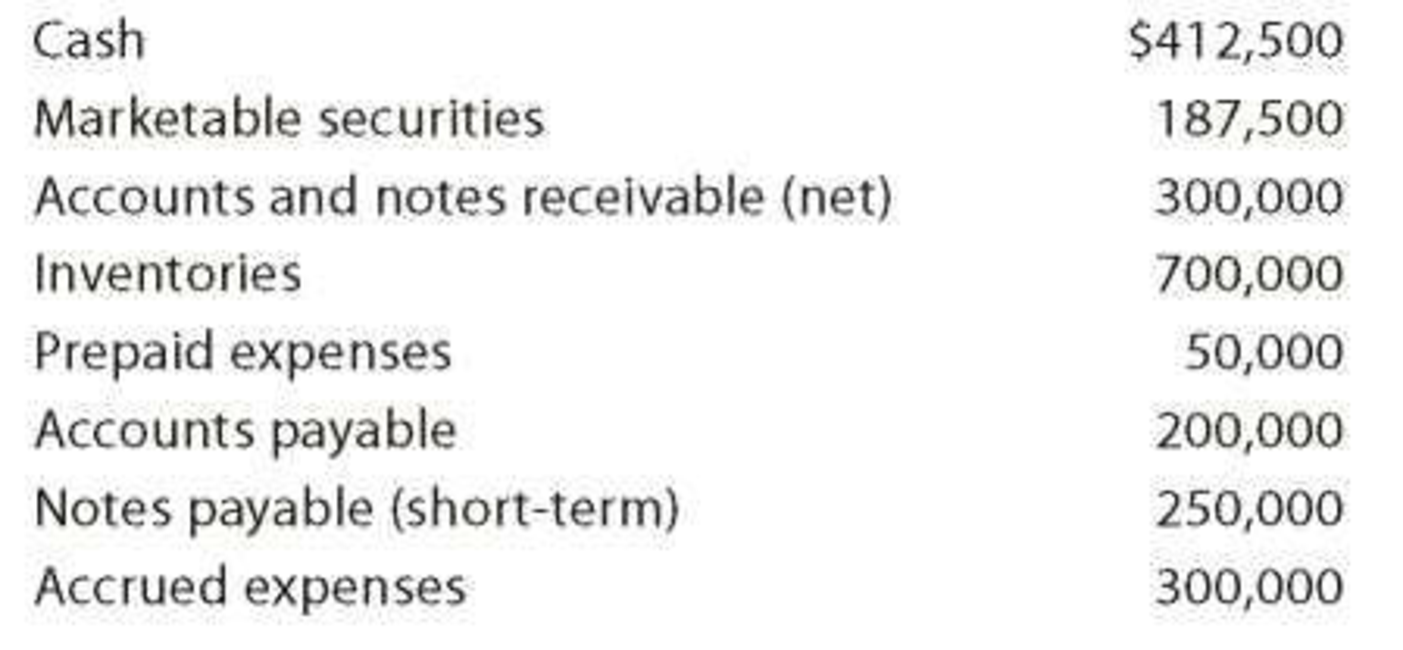
Effect of transactions on current position analysis
Data pertaining to the current position of Forte Company follow:

Instructions
1. Compute (a) the
2. List the following captions on a sheet of paper:

Compute the working capital, the current ratio, and the quick ratio after each of the following transactions and record the results in the appropriate columns. Consider each transaction separately and assume that only that transaction affects the data given. Round to one decimal place.
- a. Sold marketable securities at no gain or loss, $70,000.
- b. Paid accounts payable, $125,000.
- c. Purchased goods on account, $110,000.
- d. Paid notes payable, $100,000.
- e. Declared a cash dividend, $150,000.
- f. Declared a common stock dividend on common stock, $50,000.
- g. Borrowed cash from bank on a long-term note, $225,000.
- h. Received cash on account, $125,000.
- i. Issued additional shares of stock for cash, $600,000.
- j. Paid cash for prepaid expenses, $10,000.
1) (a)
Compute working capital.
Explanation of Solution
Financial Ratios: Financial ratios are the metrics used to evaluate the liquidity, capabilities, profitability, and overall performance of a company.
Compute working capital.
Description:
Working capital is the difference between current assets and current liabilities.
Formula:
Thus, working capital is $900,000.
b)
Compute Current ratio.
Explanation of Solution
Compute current ratio.
Description:
Current Ratio: Current ratio is used to determine the relationship between current assets and current liabilities. Current ratio is determined by dividing current assets and current liabilities.
Formula:
The ideal current ratio is 2:1.
Current assets and current liabilities are determined as follows:
Thus, current ratio is 2.2.
c)
Calculate Acid-test ratio.
Explanation of Solution
Acid-Test Ratio: This ratio denotes that this ratio is a more rigorous test of solvency than the current ratio. It is determined by dividing quick assets and current liabilities. The acceptable acid-test ratio is 0.90 to 1.00. Use the following formula to determine the acid-test ratio:
Quick Assets are those assets that are most liquid. The examples of quick assets include cash and bank balances, marketable securities, and sundry debtors.
Compute quick ratio.
Description:
First, determine the quick assets as shown below:
Then, determine acid-test ratio by dividing quick assets and current liabilities. Accounts payable are the only current liabilities.
Thus, quick ratio is 1.2.
2.
Compute Working capital, Current ratio, and Quick ratio considering the given transactions.
Explanation of Solution
a)
Sale of marketable securities at no gain or loss, $70,000.
When sale of marketable securities is considered, it increases the cash and decreases the marketable securities by same amount. So, there is no effect in the working capital, current ratio, and quick ratios that are calculated in the requirement 1. Thus, working capital, current ratio, and quick ratio are determined as follows:
| Ratios | Working capital | Current ratio | Quick ratio |
| $900,000 | 2.2 | 1.2 |
b)
Payment of accounts payable at $125,000.
Payment of accounts payable involves cash and accounts payable accounts. It decreases the accounts payable and cash. Cash is a current asset and accounts payable is a current liability. Both are the decreased by $125,000.
Determine the new current assets, quick assets, and current liabilities as below:
Thus, ratios are determined as follows:
Compute working capital.
Compute current ratio.
Compute quick ratio.
c)
Purchase of goods on account $110,000.
Purchase of goods on account involves Merchandise inventory and accounts payable account. Merchandise inventory is a current asset and it is increased due to purchases made. Accounts payable is increased due to purchases made on account. So, both are increased by $110,000.
Determine the new current assets, quick assets, and current liabilities as below:
Thus, ratios are determined as follows:
Compute working capital.
Compute current ratio.
Compute quick ratio.
d.
Payment of notes payable $100,000.
Notes payable involves notes payable and cash. Notes payable is a current liability and is decreased. Cash is a current asset and decreased due to payment made. So, reduce notes payable and cash by $100,000.
Determine the new current assets, quick assets, and current liabilities as below:
Thus, ratios are determined as follows:
Compute working capital.
Compute current ratio.
Compute quick ratio.
e)
Cash dividend of $150,000 was declared.
Cash dividends involve cash dividends and dividends payable. Cash dividends are a stockholders’ equity. Dividend payable is a current liability and is increased.
Determine the new current assets, quick assets, and current liabilities as below:
Thus, ratios are determined as follows:
Compute working capital.
Compute current ratio.
Compute quick ratio.
f)
Declaration of common stock dividend on common stock, $50,000.
Common stock dividend declaration involves common stock dividends and dividends payable. Common stock dividends are a stockholders’ equity. Dividend payable is a current liability and is increased.
Determine the new current assets, quick assets, and current liabilities as below:
Thus, ratios are determined as follows:
Compute working capital.
Compute current ratio.
Compute quick ratio.
g)
Borrowal of cash from bank on a long-term note for $225,000.
Borrowal of cash from bank on a long-term note involves cash and long-term notes payable. Cash is a current asset and is increased due to borrowable of cash. Note is a long-term note and long-term liability is increased. So, only current assets and working capital is affected.
Determine the new current assets, quick assets, and current liabilities as below:
Thus, ratios are determined as follows:
Compute working capital.
Compute current ratio.
Compute quick ratio.
h)
Received cash on account, $125,000.
Receipt of cash on account is $125,000. Cash and accounts receivable are assets. Cash is an asset and increases due to receipt of cash. Accounts receivable is an asset and is decreased. So, there is no effect of this transaction.
Determine the new current assets, quick assets, and current liabilities as below:
Thus, ratios are determined as follows:
Compute working capital.
Compute current ratio.
Compute quick ratio.
i.
Issue of additional shares of stock for cash, $600,000.
Issue of additional shares of stock for cash involves Cash and common stock. Cash is an asset and increases due to issue of additional shares. Common stock is a stock and is increases. So, this affects common stock.
Determine the new current assets, quick assets, and current liabilities as below:
Thus, ratios are determined as follows:
Compute working capital.
Compute current ratio.
Compute quick ratio.
j)
Payment of cash for prepaid expenses, $10,000.
Payment of cash for prepaid expenses involves prepaid expenses and cash. Prepaid expenses are asset. Prepaid expenses decrease and cash decreases. Thus, there is no effect.
Determine the new current assets, quick assets, and current liabilities as below:
Thus, ratios are determined as follows:
Compute working capital.
Compute current ratio.
Compute quick ratio.
The calculated ratios are as follows:
| Transaction | Working capital | Current ratio | Quick ratio |
| a. | $900,000 | 2.2 | 1.2 |
| b. | $900,000 | 2.4 | 1.2 |
| c. | $900,000 | 2.0 | 1.0 |
| d. | $900,000 | 2.4 | 1.2 |
| e. | $750,000 | 1.8 | 1.0 |
| f. | $900,000 | 2.2 | 1.2 |
| g. | $1,125,000 | 2.5 | 1.5 |
| h. | $900,000 | 2.2 | 1.2 |
| i. | 1,500,000 | 3.0 | 2.0 |
| j. | $900,000 | 2.2 | 1.2 |
Want to see more full solutions like this?
Chapter 17 Solutions
Financial Accounting
- A company discarded a storage cabinet it had originally purchased for $14,500. The cabinet had $9,700 worth of accumulated depreciation. The company should recognize a (an): (a) $14,500 loss. (b) $0 gain or loss. (c) $9,700 loss. (d) $4,800 loss. (e) $4,800 gain.arrow_forwardPlease provide the correct answer to this general accounting problem using accurate calculations.arrow_forwardCan you show me the correct approach to solve this financial accounting problem using suitable standards?arrow_forward
- I need help with this solution and accountingarrow_forwardWhat does the term "liquidity" refer to in finance? A) The ability to convert assets into cash quickly without significant loss of value B) The ability to increase company profits C) The level of debt in the company D) The diversity of the investment portfolioarrow_forwardNeed help! What is the inventory turnover ratio if cost of goods sold is $90,000 and average inventory is $15,000?A. 3B. 6C. 9D. 12arrow_forward
 Financial AccountingAccountingISBN:9781337272124Author:Carl Warren, James M. Reeve, Jonathan DuchacPublisher:Cengage Learning
Financial AccountingAccountingISBN:9781337272124Author:Carl Warren, James M. Reeve, Jonathan DuchacPublisher:Cengage Learning Managerial AccountingAccountingISBN:9781337912020Author:Carl Warren, Ph.d. Cma William B. TaylerPublisher:South-Western College PubCentury 21 Accounting Multicolumn JournalAccountingISBN:9781337679503Author:GilbertsonPublisher:Cengage
Managerial AccountingAccountingISBN:9781337912020Author:Carl Warren, Ph.d. Cma William B. TaylerPublisher:South-Western College PubCentury 21 Accounting Multicolumn JournalAccountingISBN:9781337679503Author:GilbertsonPublisher:Cengage College Accounting, Chapters 1-27AccountingISBN:9781337794756Author:HEINTZ, James A.Publisher:Cengage Learning,Principles of Accounting Volume 1AccountingISBN:9781947172685Author:OpenStaxPublisher:OpenStax College
College Accounting, Chapters 1-27AccountingISBN:9781337794756Author:HEINTZ, James A.Publisher:Cengage Learning,Principles of Accounting Volume 1AccountingISBN:9781947172685Author:OpenStaxPublisher:OpenStax College





